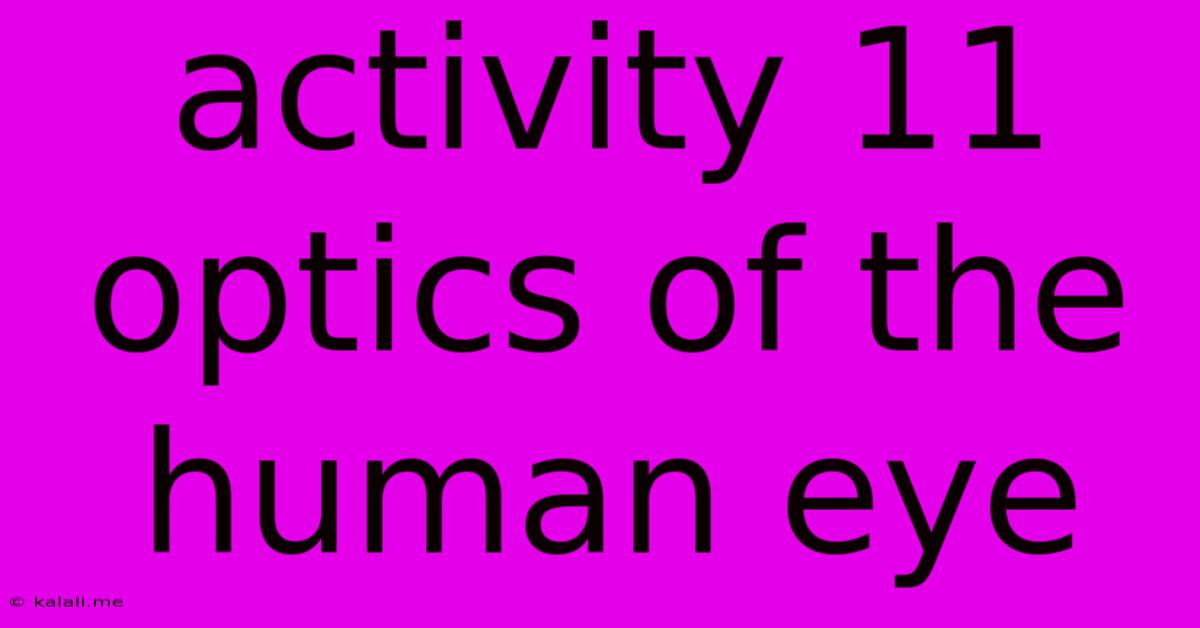Activity 11 Optics Of The Human Eye
Kalali
Jun 02, 2025 · 3 min read

Table of Contents
Activity 11: Optics of the Human Eye – A Deep Dive into Vision
This article serves as a comprehensive guide to Activity 11, focusing on the fascinating optics of the human eye. We'll explore the structures involved, how light is processed, common vision problems, and the technological advancements mimicking the eye's capabilities. Understanding the intricacies of the eye's optical system is crucial for appreciating the marvel of vision and the challenges faced in correcting vision impairments.
Understanding the Eye's Optical System:
The human eye functions as a sophisticated optical instrument, effectively capturing and processing light to create the images we perceive. Key components involved in this process include:
- Cornea: The transparent outer layer of the eye, responsible for initial light refraction (bending). It contributes significantly to the eye's focusing power.
- Pupil: The adjustable opening in the iris that controls the amount of light entering the eye. Its size changes based on ambient light conditions – constricting in bright light and dilating in dim light.
- Iris: The colored part of the eye surrounding the pupil, containing muscles that control pupil size.
- Lens: A flexible, transparent structure behind the pupil. It further refracts light and adjusts its shape (accommodation) to focus images onto the retina, allowing for clear vision at various distances.
- Retina: The light-sensitive inner lining of the eye, containing photoreceptor cells (rods and cones) that convert light into electrical signals. Rods detect low-light levels, enabling night vision, while cones are responsible for color vision and visual acuity.
- Optic Nerve: Transmits the electrical signals from the retina to the brain, where they are interpreted as images.
Light Refraction and Image Formation:
The process of vision begins with light rays entering the eye. These rays are refracted (bent) by the cornea and lens, converging to form a sharp image on the retina. This process is governed by the laws of optics, specifically Snell's Law, which describes the relationship between the angles of incidence and refraction of light passing between media of different refractive indices. The lens's ability to change its shape is crucial for focusing on objects at different distances – a process known as accommodation.
Common Vision Problems and Corrections:
Difficulties in focusing light correctly onto the retina can lead to various vision problems:
- Myopia (Nearsightedness): The eyeball is too long, or the lens refracts light too strongly, causing distant objects to appear blurry. Corrected with concave lenses.
- Hyperopia (Farsightedness): The eyeball is too short, or the lens doesn't refract light enough, leading to blurry near vision. Corrected with convex lenses.
- Astigmatism: An irregular curvature of the cornea or lens, causing distorted vision. Corrected with cylindrical lenses or refractive surgery.
- Presbyopia: Age-related loss of accommodation, making it difficult to focus on near objects. Typically corrected with reading glasses.
Technological Advancements Inspired by the Eye:
The human eye's remarkable optical design has inspired numerous technological advancements, including:
- Cameras: The lens system in cameras mirrors the eye's ability to focus light and create images. Improvements in camera technology often draw inspiration from the biological mechanisms of vision.
- Telescopes and Microscopes: These instruments utilize lenses and mirrors to magnify objects, echoing the principles of light refraction and image formation in the eye.
- Artificial Vision Systems: Researchers continue to develop artificial vision systems, attempting to replicate the complex processes of light detection and image processing within the human eye.
Conclusion:
Activity 11, focusing on the optics of the human eye, offers a fascinating exploration of this complex and remarkable sensory organ. From understanding the intricate interplay of its components to the common vision problems and technological innovations inspired by its design, the study of the eye's optical system provides invaluable insights into the science of vision and the ongoing quest to improve human sight. Further exploration into specific areas, such as the photochemistry of the retina or the neural processing of visual information, can deepen your understanding of this vital aspect of human biology.
Latest Posts
Latest Posts
-
How To Store Shipment Fallout 4
Jun 03, 2025
-
Why Did The Bicycle Fall Over
Jun 03, 2025
-
Meaning Of Eleven In The Bible
Jun 03, 2025
-
Who Does Todoroki Have A Crush On
Jun 03, 2025
-
How Long Will A Refrigerator Stay Cold
Jun 03, 2025
Related Post
Thank you for visiting our website which covers about Activity 11 Optics Of The Human Eye . We hope the information provided has been useful to you. Feel free to contact us if you have any questions or need further assistance. See you next time and don't miss to bookmark.